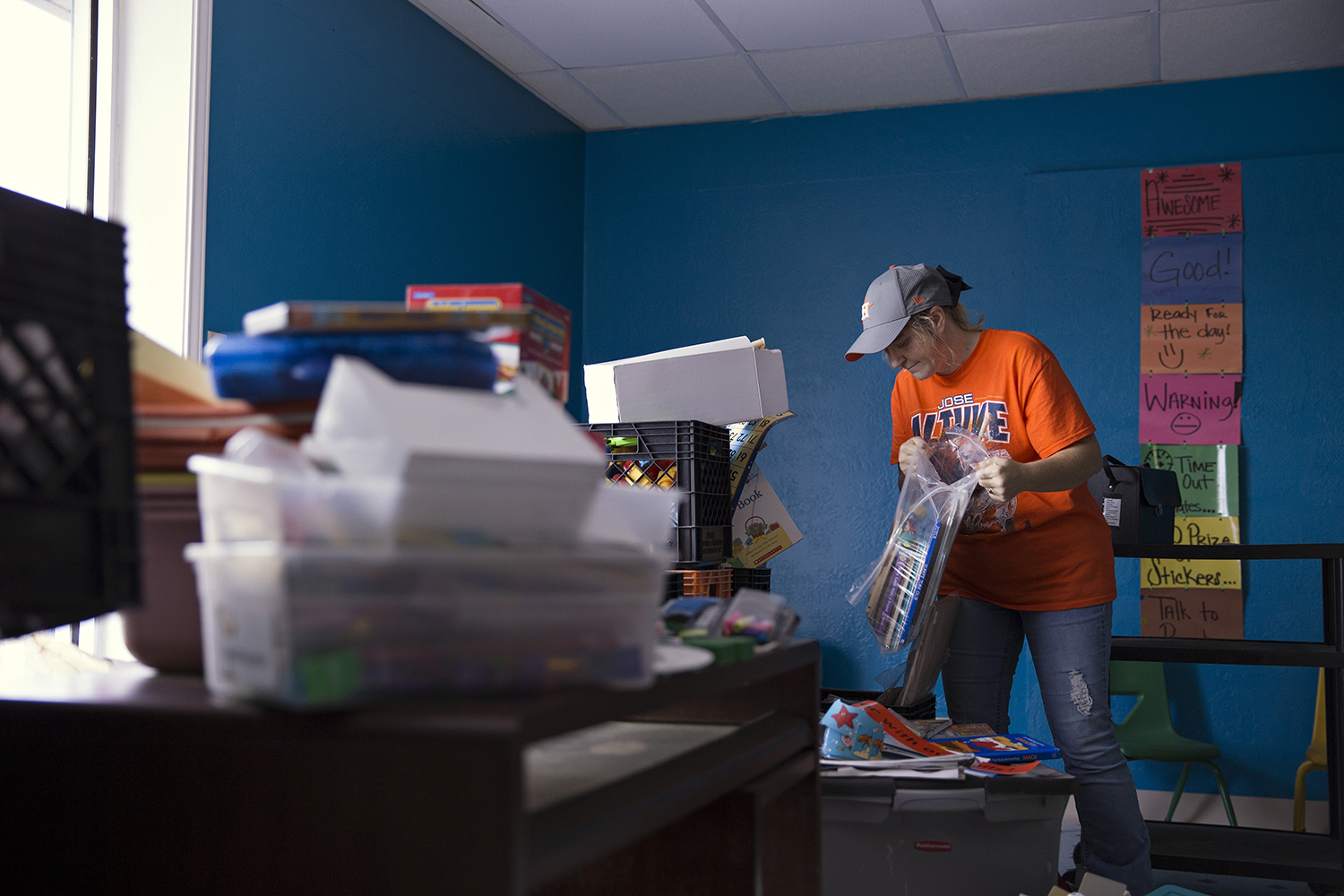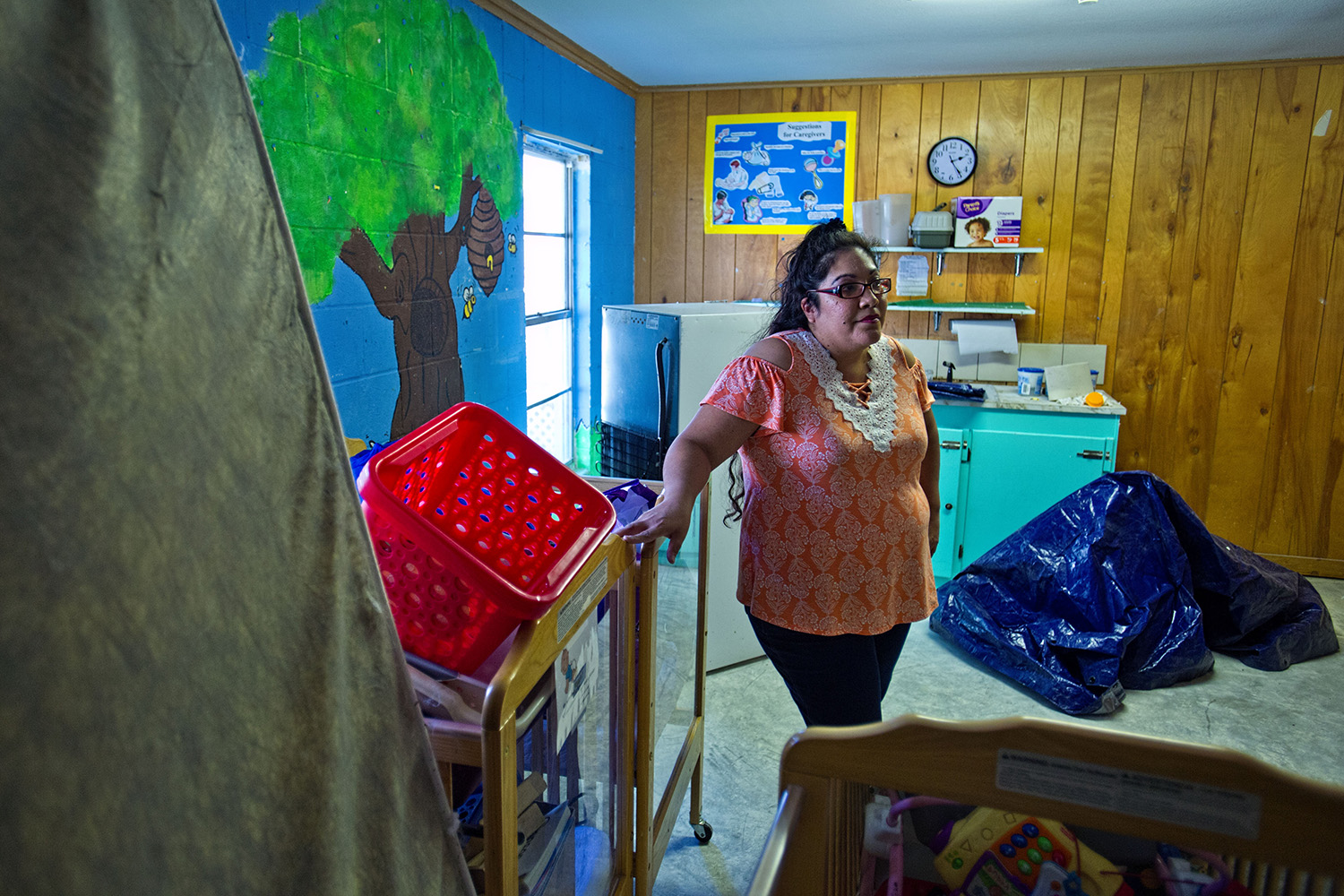Without recovery funds, more than 50 Texas day cares close after Harvey
/https://static.texastribune.org/media/images/2017/11/13/Harvey_Childcare_Centers_PYH0144_TT.jpg)
In Harvey's Wake

The devastation was swift, and the recovery is far from over. Sign up for our ongoing coverage of Hurricane Harvey's aftermath.
More in this seriesORANGE — With her husband incarcerated on a murder charge, Jacquene Fontenot single-handedly wakes and dresses five kids under the age of 5 every morning, drops them off at a local child care center and drives two hours to her job as a custodian in central Louisiana.
Fontenot, who lost her furniture when her apartment in Orange flooded during August's hurricane, could not imagine what she would do if she lost her child care. "I really don't have a second option," she said.
During Hurricane Harvey, the James Hope Center, her children's for-profit day care, took on water and a layer of mold began carpeting its walls, leaving owner Jacqueline James floundering for a solution that wouldn't leave more than 100 families, many of them low-income, stranded.
Across Harvey-affected counties, 52 child care centers have permanently closed and an additional 65 are voluntarily suspended and expected to reopen with three months, as of Nov. 10, according to the Texas Health and Human Services Commission. Those facilities had the capacity to serve almost 5,000 children.
With so many day cares closed and more in danger of closing, parents face difficulty moving back to their homes and getting back to normal, with no one to take care of their kids when they're at work. Private child care centers, often run by individuals, churches or nonprofits, are struggling to recover from the hurricane's destruction, especially in rural communities where they are among few options.
"For communities to be able to recover economically, you have to get your child care and early education programs up so people can get back to work," said Jeanne-Aimee De Marrais, senior director for U.S. emergencies at Save the Children, a nonprofit international aid group working to help child care centers recover from Harvey. "The communities are not going to get fully back up until the child care is back."
Many child care centers are small, for-profit businesses that don't qualify for federal disaster funding despite the crucial services they provide to families, De Marrais said.
The Federal Emergency Management Agency only provides public assistance to nonprofit centers, including those run by churches, according to a FEMA spokesperson. Directors of for-profit centers can apply for federal disaster loans through the U.S. Small Business Administration, but they often do not qualify, De Marrais said.
In the Houston region, many of the damaged centers accept children from families who received subsidies through the Texas Workforce Commission, according to Christina Triantaphyllis, chief officer of public policy for the early education nonprofit Collaborative for Children. Almost 40 percent of 977 centers the nonprofit surveyed had no flood insurance.
"The uncertainty is probably the number one challenge for both families and child care programs," Triantaphyllis said. "Are [child care centers] going to replace materials and move on and then hope that there's reimbursement later, or do they operate at the level they can with the materials they have left?"

In Orange, James plowed forward with the resources she had. She got the state to let her shut down her family's restaurant and use the open eating space as a temporary center for about 60 older children. She and her husband own an additional building already in use to care for about 25 infants. And she found a former bakery up for lease in West Orange and put her family members to work replacing ceiling tiles and ripping out walls to create a permanent center.
Last week she started offering day care and after-school activities in the new building for kids 18 months to 12 years old.
"Children have to know safety, and they have to know you're consistent," she said. "We are still right now feeding kids who are going home with nothing to eat. We're still clothing kids who still don't have any."
The new normal for James is a building with a smaller capacity. Many families were forced to leave Orange after three low-income apartment buildings flooded and shut down, and not all are back, she said. Just seven of 15 staff members are back in Orange; the others remain displaced after Harvey.
Lack of child care is one of many factors keeping families from returning to their homes, De Marrais said.
Farther south along the coast, LaVeta Rodriguez, director of Little Lights Learning Center in Rockport, drained the day care's savings — more than $10,000 — for renovations after major water damage in the roof and ceiling. Most of the community around the day care has not yet returned.
Dependent on the tourism industry, many Rockport residents can't count on employment now that restaurants and hotels are out of service, said Timothy Baylor, the day care's founder and pastor of New Beginnings Ministries, which houses Little Lights.
The day care lost eight of 10 staff members and a larger percentage of its students. With not enough staff or students to operate, Rodriguez and Baylor surrendered Little Lights' child care license, hoping to reapply and reopen once Rockport is rebuilt. They are using money they've raised to host a full-day program of activities and meals twice a week, taking children off their parents' hands while they look for work.
The families who are back, rebuilding their homes, are asking for child care.
"In the relief tent, they're asking, 'When are you going to open? I can't work because there's no child care,'" said Jose Alvarado, a volunteer for the church and a parent at the daycare. He's the founder of a small local business repairing and detailing yachts.
Few in Rockport are thinking about their yachts, with walls of debris turning rural roads into labyrinths and homes stripped down to skeletons in battered lots. Even if Alvarado wanted to work full-time, he'd have a hard time. He and his wife, who works full-time at a medical office, are fostering an 11-year-old girl who had attended an after-school program at Little Lights Learning Center. Now, Alvarado picks her up from school every afternoon.
There aren't many other day care choices in the area. State records show just four other licensed child care centers in Aransas County, including one that is temporarily closed.

In rural areas, "there might not be another child care center within 20 or 30 miles of them," said Anna Hardway, director of programs for Save the Children. She recalled speaking to a school principal who begged her to help get the local child care center up and running so teachers and parents could get back to work.
Children at least 3 years old who meet the federal definition of homelessness, which includes many of those displaced by the hurricane, are eligible for free public pre-K in local school districts, according to the Texas Education Agency. But parents, educators and experts interviewed by The Texas Tribune said they didn't know that option was available.
With limited assistance coming from the state and federal government, some day care owners have found creative solutions.
When Harvey swept through the coastal town of Portland, Methodist Day School's flat roof turned into a "swimming pool," and water leaked into the building, said the day care's director, Jamie Hartley. "Our building isn't really old and it's in good condition, so we weren't expecting for the building to be damaged at all," she said.
As they wait for their roof to be rebuilt, the day care's directors are indefinitely leasing space from the Gregory-Portland school district for $3,259 per month.
Paul Clore, superintendent of Gregory-Portland ISD, said the day care is welcome to lease the space for as long as they need. "It's important to us to support them," he said. "Those youngsters will eventually be students of ours."
Support for this reporting was provided by the Fund for Investigative Journalism.
Information about the authors
Learn about The Texas Tribune’s policies, including our partnership with The Trust Project to increase transparency in news.
/https://static.texastribune.org/media/profiles/Aliyya_Swaby_TT.jpg)